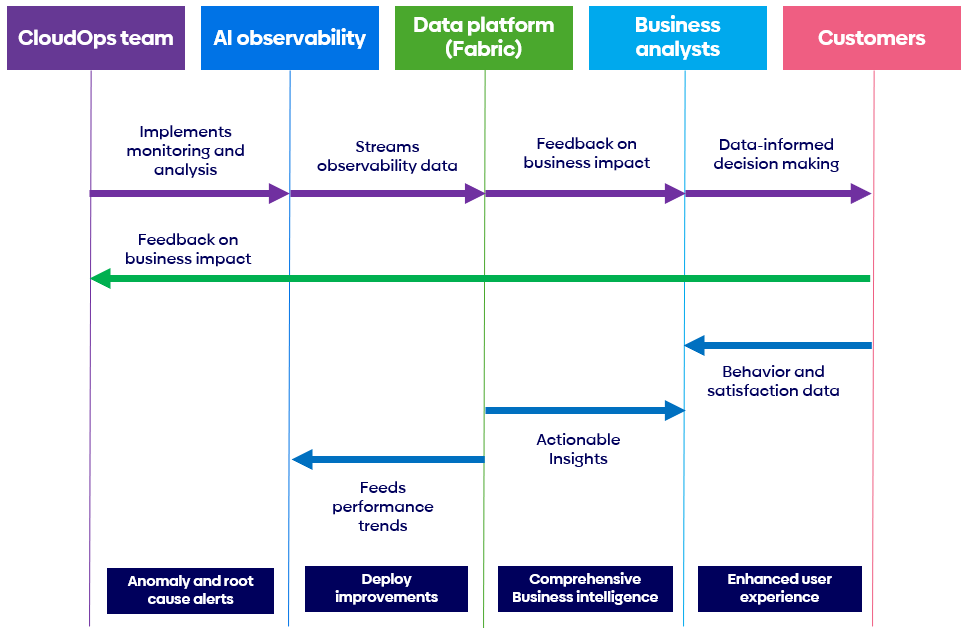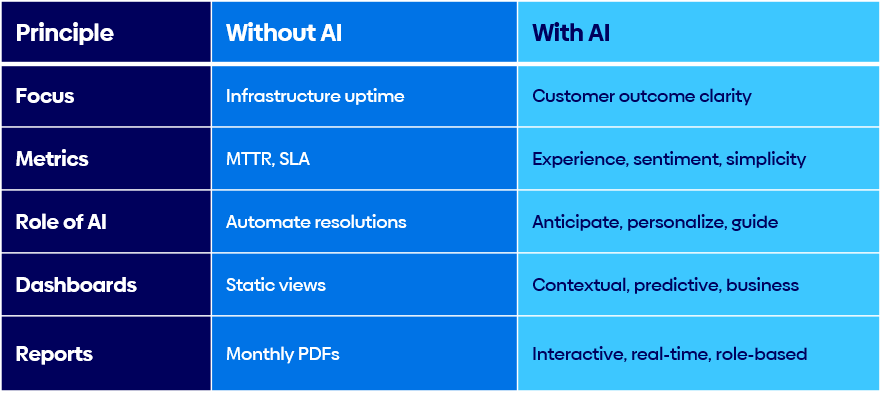The strategic edge: Leveraging CloudOps and AI for a unique business advantage
Today, IT is facing a strategic imperative: bringing operations in the cloud to the next level, generating business insights through AI-augmented Cloud Operations (CloudOps).
It has become increasingly obvious that CloudOps plays a pivotal role that extends beyond virtual infrastructure management and maintenance. CloudOps combines IT operations and best practices for managing cloud environments to get the most value out of cloud services.
To thrive in today's dynamic digital landscape, businesses must leverage CloudOps as a proactive engine for efficiency, growth, and enhanced customer experiences, such as reducing downtimes or suggesting products or services that match customer profiles, to name a few basic examples.
Purely, reactive approaches need to be replaced with proactive approaches and flexible, sustainable business strategies, as even minor delays can significantly impact revenue and customer satisfaction.
The value of AI-augmented observability
AI-augmented observability represents a significant evolution in cloud management practices. Its impact goes beyond simply monitoring; it offers a transformative approach to understanding and optimizing cloud environments. It considers the potential for enabling trend analysis and incident prediction, reducing downtime and improving business continuity. AI observability not only reduces time to resolve existing incidents but also prevents potential incidents by predicting issues before they occur.
After migrating 30 customers from traditional to AI-augmented observability, we noticed an immediate reduction of about 50% in incidents and further decrease of the probability of future incidents through predictive capabilities. These real-world benchmarks from our recent deployments allowed us to measure a substantial 60% acceleration in the resolution of cloud performance issues by utilizing AI's precise root cause analysis capabilities.
Aiming for tangible business advantages
The benefits of this transformation are not limited to technical domains; they directly translate into measurable business improvements. By leveraging AI-augmented observability, organizations can move from a reactive to a proactive operational posture, which has a significant impact on both the top and bottom line. Studies from leading industry analysts and technology providers quantify these advantages:
- Revenue momentum. Faster page responsiveness quickens the pace of buying. AI-augmented observability finds the micro-latency that quietly kills checkouts and fixes it before customers feel it. The outcome is simple: more conversions — 0.1s faster load time of mobile site data lifted retail conversions by ~8% (Deloitte).
- Risk containment. Incidents will happen. The job is to spot them early and shrink the impact. Predictive signals and fast isolation turn potential crises into footnotes — this is critical when 54% of significant outages cost more than $100,000 and ~20% exceed $1 million (Uptime Institute Global Data Center Survey 2024).
- Cost to serve. Too many teams drown in alert noise (false alarms) and swivel between too many tools. By automating detection, triage, and routine runbooks, teams can free capacity for productive work. Forrester’s analysis of Elastic shows that by the third year of adoption, teams spend ~85% less time on monitoring and incident-resolution time.
- Enhanced throughput and time-to-value. Stable ops clear the runway. With clean signals and fewer fire drills, business roadmaps are achievable and quality stays up. DORA’s research ties practice to outcomes — teams with generative cultures show ~30% higher organizational performance.
- A finance story with finesse. Dashboards don’t sell themselves. Returns do. Fewer degradations, faster recovery, and lower toil add up — Forrester’s TEI on Dynatrace reports a 274% three-year ROI via AI-assisted observability.
- Spend discipline. Cost isn’t just a finance line item; it’s an operations signal. Unified telemetry helps kill orphaned resources, right-size capacity, and schedule work to the economics. Many studies suggest more than 25% of resource wastage.
Achieving results with AI-augmented CloudOps
So how can your organization achieve these types of results? First, by enhancing operational efficiency: automation and innovation as key drivers. And second, by leveraging data platforms and diverse operating models for business success. Let’s examine how.
1. Automation and innovation: Key drivers in operational efficiency
Traditional monitoring methods often require extensive time and effort for troubleshooting. AI observability offers a solution by significantly streamlining these processes through:
- A smart automation of routine monitoring tasks, thereby freeing up technical resources.
- The empowerment of technical teams to concentrate on strategic, innovation-focused initiatives, driving business growth and competitive advantage.
- A considerable reduction in operational overhead, allowing for budget reallocations.
2. Data platforms and diverse operating models
The insights derived from AI-augmented observability can be further amplified by integrating with a robust data platform such as Microsoft Fabric. This enables the ingestion and analysis of observability data to provide comprehensive business intelligence, facilitating:
- A holistic understanding of cloud performance and its direct correlation with critical business metrics
- The creation of advanced reports and dashboards that offer actionable insights into customer behavior, highlight revenue-impacting issues, and support future trend forecasting
- Data-informed decision-making across various CloudOps operating models, including regional DevOps, global shared services, and industry-specific approaches, by providing a centralized analytical foundation
- AI integration for financial optimization by predicting business peaks and troughs, enabling resource allocation and deallocation based on demand, leading to cost savings
Different CloudOps operating models can also be effectively enhanced through the implementation of AI-augmented observability and platforms like Fabric. Here are three applicable use cases:
- Centralized observability data within Fabric supports shared DevOps models by identifying common challenges and optimizing shared resources across multiple projects.
- Localized observability insights within Fabric empower regional DevOps teams to address region-specific performance issues and compliance requirements effectively.
- Tailored AI-augmented insights and Fabric report align with specific industry KPIs and regulatory frameworks in industry-focused CloudOps strategies.
Visualizing AI-augmented observability in CloudOps
The interaction between AI-augmented observability, CloudOps teams, and data platforms is crucial for driving business success.
The diagram below illustrates how AI observability integrates with a data platform (such as Microsoft Fabric) to deliver actionable insights, optimize operations and enhance customer experiences.
AI-augmented observability in CloudOps: From monitoring to business impact

Diagram: AI-augmented observability in CloudOps: from monitoring to business impact
Key takeaways from this flow:
- CloudOps teams implement monitoring and analysis to ensure proactive anomaly detection.
- AI observability sends critical alerts and streams data for deeper analysis.
- Data platforms like Microsoft Fabric generate dashboards that provide business analysts with key insights.
- DevOps units take action on these insights into applications, directly impacting customer experience and business outcomes.
- Customers interact with optimized services, feeding behavior data back into the ecosystem for continuous improvement.
Strategic imperative: Embracing a business-centric approach to CloudOps
In today's environment, CloudOps must evolve from a cost center to a critical engine for business value. AI-augmented observability offers the capabilities required to achieve this transformation by providing the insights necessary to optimize customer experience, enhance revenue generation, and improve overall operational efficiency.
The adoption of AI-augmented observability is not merely to elevate your cloud operations and realize significant business outcomes. It is advantageous as it is an essential component of a successful and sustainable cloud strategy. High-level recommendations for customers considering AI-powered CloudOps is to emphasize the importance of designing solutions around customer needs, delivering actionable insights, and ensuring transparent, usable AI-augmented experiences.
AI-elevated CloudOps: Before vs after
Moving forward to avoid falling behind
If you are looking to get your organization to proactively embrace this strategic shift and lead the way towards a more intelligent and business-focused future for cloud operations, here’s a starting point for your reflection:
Avoid building a custom AI model using only your own customers’ data. That would limit the depth and breadth of solutions, resulting in less effective outcomes.
- Leverage a solution provider. This allows customers to benefit from models trained on broader industry data, offering more comprehensive and optimized AI capabilities without compromising data security.
- Get support from an experienced advisor that has already successfully implemented similar AI-augmented CloudOps systems and processes.
Learn more about Atos’s AI-driven cloud services
Posted on: 04/11/25
Saurabh Rawat
Global Portfolio Director – Cloud & Modern Infrastructure
View detailsof Saurabh Rawat >

